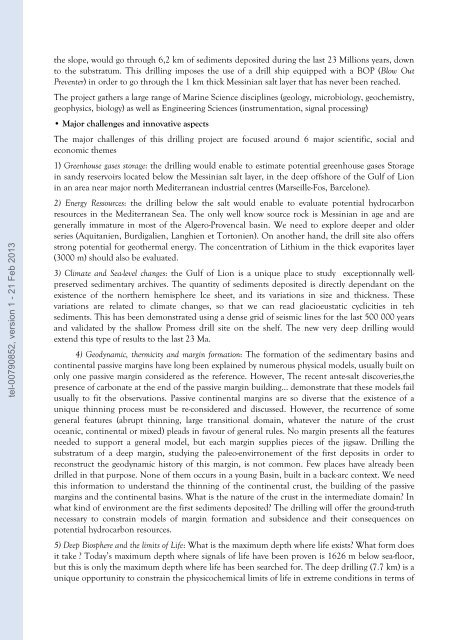Quantification des flux sédimentaires et de la subsidence du bassin ...
Quantification des flux sédimentaires et de la subsidence du bassin ...
Quantification des flux sédimentaires et de la subsidence du bassin ...
You also want an ePaper? Increase the reach of your titles
YUMPU automatically turns print PDFs into web optimized ePapers that Google loves.
tel-00790852, version 1 - 21 Feb 2013<br />
the slope, would go through 6,2 km of sediments <strong>de</strong>posited <strong>du</strong>ring the <strong>la</strong>st 23 Millions years, down<br />
to the substratum. This drilling imposes the use of a drill ship equipped with a BOP (Blow Out<br />
Preventer) in or<strong>de</strong>r to go through the 1 km thick Messinian salt <strong>la</strong>yer that has never been reached.<br />
The project gathers a <strong>la</strong>rge range of Marine Science disciplines (geology, microbiology, geochemistry,<br />
geophysics, biology) as well as Engineering Sciences (instrumentation, signal processing)<br />
• Major challenges and innovative aspects<br />
The major challenges of this drilling project are focused around 6 major scientific, social and<br />
economic themes<br />
1) Greenhouse gases storage: the drilling would enable to estimate potential greenhouse gases Storage<br />
in sandy reservoirs located below the Messinian salt <strong>la</strong>yer, in the <strong>de</strong>ep offshore of the Gulf of Lion<br />
in an area near major north Mediterranean in<strong>du</strong>strial centres (Marseille-Fos, Barcelone).<br />
2) Energy Ressources: the drilling below the salt would enable to evaluate potential hydrocarbon<br />
resources in the Mediterranean Sea. The only well know source rock is Messinian in age and are<br />
generally immature in most of the Algero-Provencal basin. We need to explore <strong>de</strong>eper and ol<strong>de</strong>r<br />
series (Aquitanien, Burdigalien, Langhien <strong>et</strong> Tortonien). On another hand, the drill site also offers<br />
strong potential for geothermal energy. The concentration of Lithium in the thick evaporites <strong>la</strong>yer<br />
(3000 m) should also be evaluated.<br />
3) Climate and Sea-level changes: the Gulf of Lion is a unique p<strong>la</strong>ce to study exceptionnally wellpreserved<br />
sedimentary archives. The quantity of sediments <strong>de</strong>posited is directly <strong>de</strong>pendant on the<br />
existence of the northern hemisphere Ice she<strong>et</strong>, and its variations in size and thickness. These<br />
variations are re<strong>la</strong>ted to climate changes, so that we can read g<strong>la</strong>cioeustatic cyclicities in teh<br />
sediments. This has been <strong>de</strong>monstrated using a <strong>de</strong>nse grid of seismic lines for the <strong>la</strong>st 500 000 years<br />
and validated by the shallow Promess drill site on the shelf. The new very <strong>de</strong>ep drilling would<br />
extend this type of results to the <strong>la</strong>st 23 Ma.<br />
4) Geodynamic, thermicity and margin formation: The formation of the sedimentary basins and<br />
continental passive margins have long been exp<strong>la</strong>ined by numerous physical mo<strong>de</strong>ls, usually built on<br />
only one passive margin consi<strong>de</strong>red as the reference. However, The recent ante-salt discoveries,the<br />
presence of carbonate at the end of the passive margin building… <strong>de</strong>monstrate that these mo<strong>de</strong>ls fail<br />
usually to fit the observations. Passive continental margins are so diverse that the existence of a<br />
unique thinning process must be re-consi<strong>de</strong>red and discussed. However, the recurrence of some<br />
general features (abrupt thinning, <strong>la</strong>rge transitional domain, whatever the nature of the crust<br />
oceanic, continental or mixed) pleads in favour of general rules. No margin presents all the features<br />
nee<strong>de</strong>d to support a general mo<strong>de</strong>l, but each margin supplies pieces of the jigsaw. Drilling the<br />
substratum of a <strong>de</strong>ep margin, studying the paleo-envirronement of the first <strong>de</strong>posits in or<strong>de</strong>r to<br />
reconstruct the geodynamic history of this margin, is not common. Few p<strong>la</strong>ces have already been<br />
drilled in that purpose. None of them occurs in a young Basin, built in a back-arc context. We need<br />
this information to un<strong>de</strong>rstand the thinning of the continental crust, the building of the passive<br />
margins and the continental basins. What is the nature of the crust in the intermediate domain? In<br />
what kind of environment are the first sediments <strong>de</strong>posited? The drilling will offer the ground-truth<br />
necessary to constrain mo<strong>de</strong>ls of margin formation and subsi<strong>de</strong>nce and their consequences on<br />
potential hydrocarbon resources.<br />
5) Deep Biosphere and the limits of Life: What is the maximum <strong>de</strong>pth where life exists? What form does<br />
it take ? Today’s maximum <strong>de</strong>pth where signals of life have been proven is 1626 m below sea-floor,<br />
but this is only the maximum <strong>de</strong>pth where life has been searched for. The <strong>de</strong>ep drilling (7.7 km) is a<br />
unique opportunity to constrain the physicochemical limits of life in extreme conditions in terms of

















